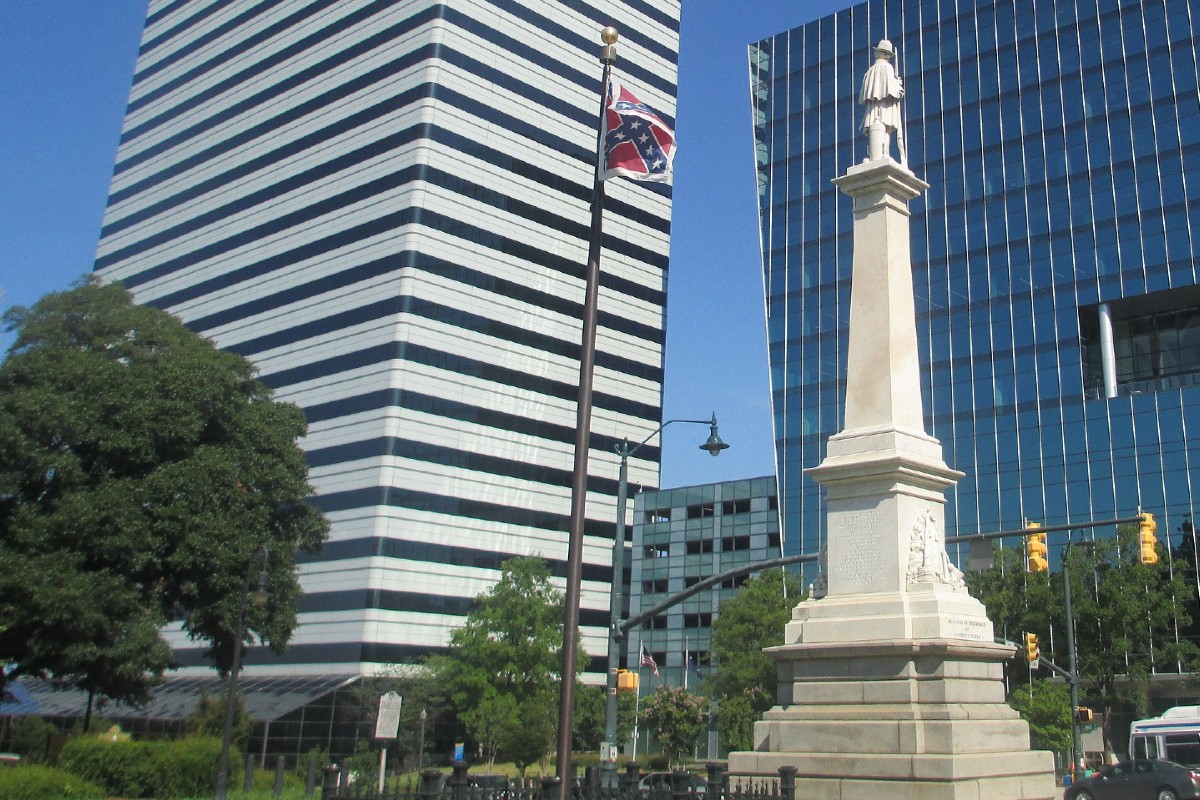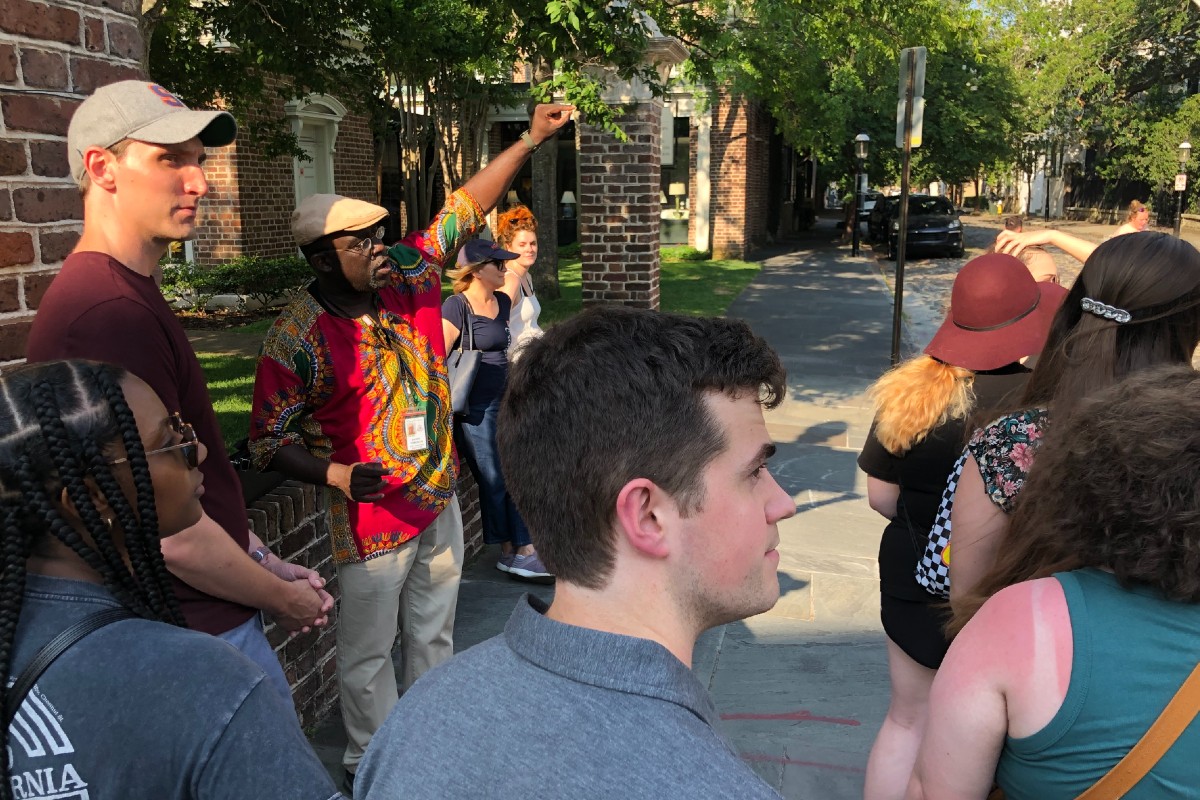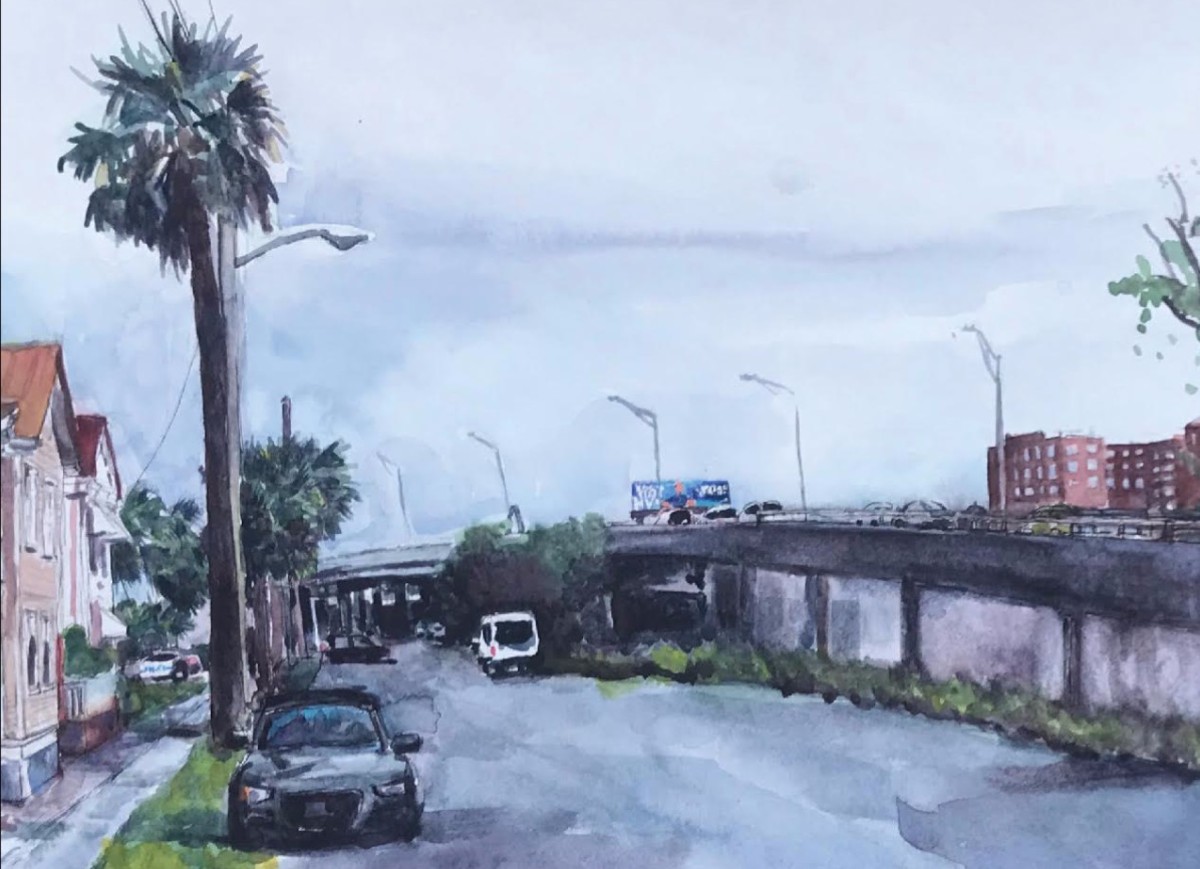Charleston Currents #13.29 | May 31, 2021
POINTING OUT THE SITES. Local tour guide and historian Damon Fordham, pictured in the red shirt, gives a downtown walking tour to a group of master’s degree students from Syracuse University. The students are working on stories and reviews about Spoleto Festival USA and Piccolo Spoleto Festival that will appear in the Charleston City Paper over the next two weeks. Check out what they’re doing online. See something you think our readers would enjoy? Snap a shot and send it along to editor@charlestoncurrents.com. Copyrighted photo by Andy Brack.
FOCUS: Redux hosts opening of two new exhibitions
COMMENTARY, Brack: Throw out the Heritage Act
IN THE SPOTLIGHT: Charleston RiverDogs
NEWS BRIEFS: Big ship stops by port of Charleston
FEEDBACK: Use opioid funds carefully, transparently
MYSTERY PHOTO: Wild mural
CALENDAR: Photos come alive in museum’s new Living Color exhibit
Redux hosts opening of two new art exhibitions
Staff reports | The Redux Contemporary Art Center opens two new shows this week with one dedicated to a talented watercolorist and the other featuring works of several studio artists.
Charleston native Becca Hopkins offers a series of poignant watercolors June 4 to June 17 in her first solo show at Redux’s Gallery 1056. Called, “Expressway” and curated by Mia Loa, Hopkins’ art highlights the “immensity and artificiality of the Septima P. Clark Expressway stands in jarring contrast with the soft and settled 19th and early 20th century homes around it. It is an alien and alienating landscape that interrupted the human ebb-and-flow of mid-century Charleston,” according to the gallery.
A generation ago, the highway carved through a tight-knit predominantly Black community, displacing approximately 150 residences and businesses in its path. Ironically, it was later named after one of the leading figures of the civil rights movements during the 20th century.
“Drawing on this history and conversations with local activists, as well as the artist’s position as a public servant, Becca Hopkins painted Expressway as a visual exploration of the Septima P. Clark Expressway. She uses watercolor because of its fluidity and dreaminess soften the hard edges of the concrete, asphalt and steel landscape. Charlestonians live with water, making the medium all the more appropriate to describe sunny, dry days, rain and puddles, and the significant floodwaters left over from a downpour.”
The opening reception is 5 p.m. to 8 p.m. June 4, the first day of the show. It runs through June 17.
Redux Studio Artist Exhibition opens, too
 Also on tap this week is the annual Redux Studio Artist Exhibition, which is on display June 4-17 and shares the opening reception.
Also on tap this week is the annual Redux Studio Artist Exhibition, which is on display June 4-17 and shares the opening reception.
The “Creative Corridors” exhibition allows resident Redux artists to showcase a sample of their work as it relates to a specific prompt and is curated as a group exhibition in Redux’s main exhibition space.
“For Creative Corridors 2021, we asked the Redux Studio Artists to consider the ‘why’ behind their individual artistic practices,” according to a press release. “The creation of a new piece of artwork can serve as a meditative process for artists. As a new piece of work comes to life from the hands of an artist, intention plays a significant role in the evolution of each piece. Sometimes the work deviates from the original intention, but the overarching concept of the artist’s “why” remains ever present.”
Exhibiting Redux studio artists in the show include: Abe Garcia, Alice Keeney, Barb Montgomery, Bob Fine, Celeste Caldwell, Christine Patterson, Connor Lock, George Read, Hale Horstman, Jenifer Padilla, Jordan Cave, Julia Harmon, Karen Vournakis, Kate Comen, Kate Ritchie, Katie Libby, Kevin Foltz, Kirsten Hoving, Kris Hanson, Madison Kingery, Marie Carladous, Megan Collier-Bansil, Mia Loia, Morgan Kinne, Nancy Perry, Rebecca Hopkins, Shelby Corso, Susan Altman, Susan Perkins, Susan Vitali and Todd Anderson.
- More information: Redux Contemporary Art Center, 1056 King St., Charleston.
- Have a comment? Send to: editor@charlestoncurrents.com.
Throw out the Heritage Act

A Confederate battle flag flew next to a monument on the Statehouse grounds in 2012, three years before the flag was removed. Via Wikipedia.
By Andy Brack, editor and publisher | The guy from Long Island smoking a big cigar didn’t think historic statues and memorials should be removed. To do so would be a way for the present generation to try to whitewash the history of the past — to rid these tributes from the state’s collective conscience and keep people from remembering how things were.
 Good point, but what about the people in the state for whom the memorials serve as offensive reminders of an economy built on the backs of their enslaved forefathers? Could the guy see how maintaining memorials might be little more than an attempt by a past generation to remind future generations about white supremacy?
Good point, but what about the people in the state for whom the memorials serve as offensive reminders of an economy built on the backs of their enslaved forefathers? Could the guy see how maintaining memorials might be little more than an attempt by a past generation to remind future generations about white supremacy?
Yep, he could understand that and hadn’t really considered how effigies in stone could channel values of the past as cold reminders to reinforce those values far into the future. But he still didn’t like the idea of taking down statues, even if they were put in a museum.
Let’s turn back the clock. A generation after the Civil War, a monument movement swept through the country. In the North, communities erected statues as tributes to soldiers who fought to protect the republic and maintain American democracy.
Southerners also erected statues, but they served as more than war memorials. They also were symbols that constantly reminded people of white supremacy and the “Lost Cause” of the Confederacy. Interestingly, many Southern statues look remarkably like those in the North. The major difference: the “C.S.” (Confederate States) on belt buckles instead of a “U.S.” (United States). That’s because many Southern memorials were built by factories in New England with prefabricated parts, according to The Washington Post.
Over time, calls grew to remove Confederate symbols in the public sphere. In 1962, South Carolina legislators approved a resolution to fly a Confederate battle flag on the Statehouse dome to commemorate the centennial of the Civil War. Because the legislative resolution didn’t set a time for removing the flag, it stayed up until 2000, when lawmakers hammered out a compromise to move it to be near a monument in front of the Statehouse in Columbia. In 2015, the flag was moved off the Statehouse grounds.
But the 2000 compromise, called the Heritage Act, also included provisions barring removal or alteration of monuments to 10 wars as well as those honoring Native American and African American history. While that might sound tepid at first blush, it was clear the compromise was to keep people’s hands off Confederate monuments because the legislature, which passed the Heritage Act with a simple majority vote, required a two-thirds vote by future legislatures to remove any monument.
And now, as America takes a Memorial Day break to remember heroes who died for the country, South Carolina is still arguing about old wars and sores.
This week, the S.C. Supreme Court heard arguments about the constitutionality of the Heritage Act. Those trying to bat it down argued the two-thirds vote requirement was unconstitutional because it created a tough hurdle for future legislatures to jump to take down a statue or memorial. Others complained the law interfered with “home rule,” or the ability of local governments to deal with local issues.
Some also question whether the issue is even ripe for discussion. They say the legislature hasn’t tested whether a majority, much less a supermajority, wants to repeal the Heritage Act. But others point to how repeal efforts can’t get to a vote because they get stuck in House and Senate committees.
It will be months before the Supreme Court rules on the Heritage Act. While some consider the court almost evenly split between progressives and conservatives, the case before the five justices now is mercurial enough that the outcome is anything but clear.
Let’s hope they don’t kick the can down the road. At a minimum, they should throw out the supermajority voting requirement. Even better would be to let local communities decide what they want to do with their statues.
Andy Brack is editor and publisher of Charleston Currents, and publisher of the Charleston City Paper. Have a comment? Send to: editor@charlestoncurrents.com.
Charleston RiverDogs
 The season is open. Games are being played! The public spiritedness of our underwriters allows us to bring Charleston Currents to you at no cost. This issue’s featured underwriter is the Charleston RiverDogs.
The season is open. Games are being played! The public spiritedness of our underwriters allows us to bring Charleston Currents to you at no cost. This issue’s featured underwriter is the Charleston RiverDogs.
- Learn more about the RiverDogs.
- See the schedule. The team’s next home stand starts June 8.
The Lowcountry’s leader in sports entertainment, Charleston RiverDogs baseball is an attractive, affordable medium for your group or business. The RiverDogs, now affiliated with the Tampa Bay Rays, offer one of the finest ballparks in Minor League Baseball — Joseph P. Riley, Jr. Park.
Three short words sum up the everyday approach taken by the Charleston RiverDogs front office. The brainchild of club President Emeritus Mike Veeck, the nine-letter phrase “Fun Is Good” is meant to be a guideline and daily reminder of how employees should approach their jobs and in turn capture the imagination of the fans to turn them into repeat customers.
- Visit the ‘Dogs online at: RiverDogs.com
- To meet all of our underwriters, click here.
Whoa — that is a big ship
Staff reports | Hundreds of people snapped pictures last week as the largest ship ever to call on the East Coast sailed into the port of Charleston.
The South Carolina Ports Authority welcomed the record-breaking CMA CGM MARCO POLO to Wando Welch Terminal on May 28. The vessel measures 1,300 feet long and can carry up to 16,022 TEUs (twenty-foot equivalent container units). That makes the ship as long as 1.5 USS Yorktowns and seven 787-8 Boeing-made Dreamliner jets.
 “The S.C. Ports Authority has made South Carolina proud by transforming Charleston into a world-class port that attracts world-class investment and can now accommodate the largest container ships in the world,” S.C. Gov. Henry McMaster said. “We welcome the CMA CGM MARCO POLO and look forward to breaking even more records as our infrastructure continues to improve and our economy continues to grow.”
“The S.C. Ports Authority has made South Carolina proud by transforming Charleston into a world-class port that attracts world-class investment and can now accommodate the largest container ships in the world,” S.C. Gov. Henry McMaster said. “We welcome the CMA CGM MARCO POLO and look forward to breaking even more records as our infrastructure continues to improve and our economy continues to grow.”
SC Ports has invested $2 billion in port infrastructure in recent years to handle bigger ships and more cargo for customers. Work continues to enhance Wando Welch Terminal, including densifying the terminal, strengthening the berths and investing in new equipment. Wando Welch Terminal will have 15 ship-to-shore cranes with 155 feet of lift height above the wharf deck ready to work container ships later this year.
Additionally, the March opening of the Hugh K. Leatherman Terminal marked the first container terminal to open in the U.S. since 2009. The Leatherman Terminal adds much-needed port capacity and another berth to the U.S. East Coast port market.
Additionally, the U.S. Army Corps of Engineers, Charleston District is working to deepen Charleston Harbor to 52 feet; the project is progressing well and is fully funded by state and federal dollars. According to a news release, the Charleston Harbor Deepening Project achieved a significant milestone this month by reaching 52 feet in the Wando River in front of Wando Welch Terminal. When the project is fully completed in 2022, Charleston will have the deepest harbor on the East Coast at 52 feet, capable of seamlessly handling fully loaded mega container ships at any time, any tide.
“SC Ports has invested in big-ship infrastructure and terminal capacity to handle the boom in retail goods and ensure a fluid supply chain for customers. The arrival of the 16,022-TEU CMA CGM MARCO POLO highlights the importance of our big-ship strategy,” SC Ports President and CEO Jim Newsome said. “This is a big moment for South Carolina.”
In other recent news:
![]() State Supreme Court hears suit on Heritage Act. The S.C. Supreme Court on Tuesday heard its first challenge to the state law protecting Confederate and other historical monuments since its passage 21 years ago. More: AP News | The State | The Post and Courier.
State Supreme Court hears suit on Heritage Act. The S.C. Supreme Court on Tuesday heard its first challenge to the state law protecting Confederate and other historical monuments since its passage 21 years ago. More: AP News | The State | The Post and Courier.
State preps for first execution in 10 years. An inmate on South Carolina’s death row since 2002 who is suing the state over a new death penalty law has been issued an execution notice from the S.C. Supreme Court. The execution should be carried out on June 18. In May, Gov. Henry McMaster signed into law a measure that set the electric chair as the default mode of execution for those on death row, although inmates can choose death by firing squad. Read more in Statehouse Report.
Early municipal estimates for fed money off mark in S.C. Seventeen municipalities in South Carolina have learned they will receive $67.9 million less from federal coronavirus relief than they first expected. That adjusted estimate is felt differently among the towns and cities — with most seeing a 15 percent or less decline in expected funds. But for Bluffton, Conway, Mount Pleasant, Myrtle Beach, North Charleston and North Myrtle Beach, the amounts were between 39 and 80 percent lower than expected. More: The Post and Courier
A third of S.C. residents worry about eviction, foreclosures, data shows. Nearly 30 percent of South Carolinians are worried about evictions or foreclosures, according to recent data collected around the country. More: WIS TV
Howard names reestablished arts program after S.C. native. Twenty years ago, S.C. native Chadwick Boseman helped lead a student protest against Howard University’s plans to merge its College of Fine Arts into the College of Arts and Sciences. The programs merged anyway. But now, the college will again stand on its own, and bear Boseman’s name as Chadwick A. Boseman College of Fine Arts. More: AP News | NPR
Use opioid funds carefully, transparently
To the editor,
![]() As the former director (2009-2014), White House Office of National Drug Control Policy, and a Charleston resident, I am anxiously awaiting the arrival of funds from the opioid litigation settlements to South Carolina.
As the former director (2009-2014), White House Office of National Drug Control Policy, and a Charleston resident, I am anxiously awaiting the arrival of funds from the opioid litigation settlements to South Carolina.
These funds, if properly used, can have a significant impact on saving lives and reducing overdoses. States must have a comprehensive and transparent plan on how those funds will be allocated. We saw significant problems with tobacco settlement money being used for a variety of programs that had little to do with reducing smoking.
The opioid funds will certainly be less than the tobacco settlement and therefore it is incumbent on communities to watch and monitor very carefully where that money goes.
— Gil Kerlikowske, Charleston
Send us a letter
We love hearing from readers. Comments are limited to 250 words or less. Please include your name and contact information. Send your letters to: editor@charlestoncurrents.com. | Read our feedback policy.
Wild mural
We hope you enjoy this wild mural as much as we did, but where can you see it in real life? Send your best guess to editor@charlestoncurrents.com. And don’t forget to include your name and the town in which you live. And if you’ve got a clever mystery photo for our readers, send it to the same address (Try to stump us!)
Our previous Mystery Photo
 Last week’s mystery, “Familiar archway,” showed a short tunnel that people can go in and out of the Cistern Yard in front of Randolph Hall at the College of Charleston.
Last week’s mystery, “Familiar archway,” showed a short tunnel that people can go in and out of the Cistern Yard in front of Randolph Hall at the College of Charleston.
Congratulations to these readers from all over who correctly identified it: George Graf of Palmyra, Va.; Allan Peel of San Antonio, Texas; Marnie Huger of Richmond, Va.;Kristin Miguez of Mount Pleasant; Tylar Bentz and Esther Jones, both of Charleston; Kristina Wheeler of West Ashley; Jay Altman of Columbia; and William Hulcher.
Graf explained that the George Street archway was part of the Porter’s Lodge at the College of Charleston: “The building was constructed in 1850-51 during renovations and additions that re-oriented the college’s main building towards George Street. Prior to these additions, this side of the campus had been a space for privies and a firehouse. After the lodge was constructed, the college janitor was asked to keep his firewood and laundry out of the main alcove and to get rid of a cow that grazed Cistern Yard.
“The former backyard, now enclosed by a fence rather than a wall, was further transformed by the attractive proportions of the Porter’s Lodge, with arched entryways and iron gates. Today, faculty offices occupy the top floor of Porter’s Lodge, but these rooms were originally living quarters for a custodian, or “porter,” in the parlance of English universities that the college wished to emulate.”
- Send us a mystery: If you have a photo that you believe will stump readers, send it along (but make sure to tell us what it is because it may stump us too!) Send it along to editor@charlestoncurrents.com.
Photos come alive in museum’s new Living Color exhibit
Staff reports | The Charleston Museum will present The Lowcountry in Living Color: Making Historical Photographs Come to Life starting June 7 as the latest offering in its Lowcountry Image Gallery.
“Over 90 percent of the photographs housed in the Museum’s archives are black and white,” according to a press release. “And while many viewers find them historically charming, others find it difficult to see particular details within the image. By colorizing a black and white photograph, certain components otherwise overlooked, become visible.”
The Lowcountry Image Gallery is an exhibition gallery that showcases previously unseen photography and other works of art from the Museum archives. Comprising over 40,000 photographs and representing a variety of themes, subjects and locations from around the Charleston area, this collection provides a glimpse into Lowcountry life from the dawn of the photography era to the present.
- The exhibition will run from June 7 through Oct. 31. Buy tickets.
Also on the calendar:
![]() Mepkin Abbey concert: 4 p.m., May 31, Mepkin Abbey, Berkeley County. The monastery today will present its annual Memorial Day Concert in honor of Abbot Francis Kline. A trio of performers — Yuriy Bekker on violin, Nataila Khoma on cello and Volodymyr Vynnytsky on piano — will play music of Rachmaninoff. More information and tickets ($35) are online. (Tickets are limited and may be sold out.)
Mepkin Abbey concert: 4 p.m., May 31, Mepkin Abbey, Berkeley County. The monastery today will present its annual Memorial Day Concert in honor of Abbot Francis Kline. A trio of performers — Yuriy Bekker on violin, Nataila Khoma on cello and Volodymyr Vynnytsky on piano — will play music of Rachmaninoff. More information and tickets ($35) are online. (Tickets are limited and may be sold out.)
Spoleto season is underway. Charleston’s Spoleto Festival USA and Piccolo Spoleto Festival are ongoing through June 13 with performances and events all over town. You can find the printed 16-page Piccolo Spoleto 2021 guide in the Charleston City Paper and at venues around town. But because this season’s free events are being continuously updated, you might want to also check at charlestonarts.org to get the most updated information on events. Piccolo is a companion celebration to Spoleto Festival USA, which also starts May 28 and ends June 13.
Weekend beach bus. The Charleston Area Regional Transportation Authority is operating a new Beach Reach Shuttle with hourly weekend service to provide a new connection between Mount Pleasant and Isle of Palms. Landside Beach Reach parking is located along Market Center Boulevard in Mount Pleasant Towne Centre. The on-island Beach Reach stop is located at 9th Avenue and Ocean Boulevard, adjacent to public beach access. Open through Sept. 6 from 9:15 a.m. through final departure from Isle of Palms at 5:35 p.m. Cost: $2 each way.
Waterparks to open daily. Splash Zone at James Island County Park will be open daily starting June 5 through mid-August, when it will return to weekends only until Labor Day. Splash Island at Mount Pleasant Palmetto Islands County Park and Whirlin’ Waters Adventure Waterpark in the North Charleston Wannamaker County Park will be open weekends only until June 18, when they will open daily until mid-August. Both will then open on weekends through Labor Day.
Safe Sounds: Firefly Distillery, North Charleston. Head over to citypapertickets.com to secure a spot. Tickets are available now. Doors open 6 p.m. for shows that begin an hour later. (Editor’s note: City Paper Tickets, which is run by sister publication Charleston City Paper, is operating ticketing for Safe Sounds.) Check out some of the shows that are on the way:
- June 5: Motown Throwdown
- June 12: Night Moves with Taylor Hicks – A Tribute To Bob Seger
Johns Island concerts: June 5 and July 10, Johns Island County Park. The reggae sounds of Mystic vibrations on June 5 and the Motown sounds of The Legacy on July 10. For each show, gates open at 6 p.m. with music beginning at 7 p.m. Shows end by 9:30 p.m. Tickets are available for $60 per 10×10 square, not per person. Squares are limited to four people max. Guests must arrive together, as each vehicle must have a ticket for entry. Squares will be available on a first-come, first-served basis upon arrival. Each show will also offer food vendors; no outside food, alcohol or coolers will be permitted. Alcohol will be available for purchase. Patrons are encouraged to bring chairs, blankets, tables, etc. to be used at their space. Masks are required, except when eating.
Ongoing
The Lawn Party exhibition: Through Sept. 19, Charleston Museum, Meeting Street, Charleston. The Charleston Museum is pleased to present The Lawn Party: From Satin to Seersucker, the latest offering in its Historic Textiles Gallery. In an “unprecedented” era when large gatherings have been discouraged and fashion has trended towards leisurewear, this exhibition is a celebration of getting dressed up for an outdoor party. Bringing a hint of glamour to a trying time, the garments on display were selected with the grand idea of “after” in mind. This is a perfect opportunity to come see what to wear for your next outdoor event as we head toward the new “normal.”
Holy City Farmers Market: 4 p.m. to 7 p.m., every Wednesday, Holy City Brewing, North Charleston. vendors rotate weekly to provide shoppers with a tiny but mighty shopping experience. vendors will be selling a range of products from specialty foods, home and body care to arts and crafts. More info.
Birds of Prey flight demonstrations: 10:30 a.m. to 11:30 a.m. on Thursdays and Saturdays, Center for Birds of Prey, 4719 Highway 17. Awendaw. The center has reopened its doors to visitors after closing due to the COvID-19 pandemic, inviting people to once again come and explore the world of raptors through an outdoor program and flight demonstration. Tickets: . $20/adult; $15/children age 3-17.
Sunday Brunch Farmers Market: 11 a.m. to 3 p.m., every Sunday, Charleston Pour House, 1977 Maybank Highway, James Island. While the market is discouraging people from spending too much time hanging out during the market, everyone is invited to shop their local vendors. More info.
Bird-watching at Caw Caw. Every Wednesday and Saturday — particularly through the end of February — you can see a plethora of birds at Caw Caw Interpretive Center in Ravenel as they make their way through the Lowcountry. The two-hour regular walks, which start at 8:30 a.m., are through distinct habitats that allow participants to view and discuss a variety of birds, butterflies, and other organisms. Registration is not required. Participants are encouraged to bring their own binoculars. A paid chaperone is required for participants ages 15 and under. Max. 10 participants. Fee: $9; free for Gold Pass holders. Open to all ages. More: Caw Caw Interpretive Center.
- If you have any online events, drop us a line (editor@charlestoncurrents.com) and make sure to put “Online event” in the subject line. Similarly, if you’ve got cool ideas for stuff to do while in isolation at home, send them our way.
 ORDER NOW: Copies of our new book, 350 Facts About Charleston, are in Lowcountry-area bookstores now, but if you can’t swing by, you can order a copy online today.
ORDER NOW: Copies of our new book, 350 Facts About Charleston, are in Lowcountry-area bookstores now, but if you can’t swing by, you can order a copy online today.
We encourage you to FORWARD your issue of Charleston Currents to your friends and encourage them to subscribe. It’s got a great price, as you know: Free! And it includes cool stuff about the community that’s hard to find elsewhere. We hope they’ll enjoy our coverage.
- DONATE. Now also would be a great time to contribute as we deal with the crisis. In advance, thank you.
OUR UNDERWRITERS
Charleston Currents is an underwriter-supported weekly online journal of good news about the Charleston area and Lowcountry of South Carolina.
- Meet our underwriters
- To learn more about how your organization or business can benefit, click here to contact us. Or give us a holler on the phone at: 843.670.3996.
OUR TEAM
Charleston Currents offers insightful community comment and good news on events each week. It cuts through the information clutter to offer the best of what’s happening locally.
- Mailing address: P.O. Box 21942, Charleston, SC 29413.
- Phone: 843.670.3996
Charleston Currents is provided to you weekly by:
- Editor and publisher: Andy Brack, 843.670.3996
- Contributing editor, common good, Fred Palm
- Contributing editor, money: Kyra Morris
- Contributing editor, Palmetto Poem: Marjory Wentworth
- Contributing photographer: Rob Byko
- Charleston Currents also uses content from the outstanding staff at the Charleston City Paper, a sister publication.
SUBSCRIBE FOR FREE
Subscriptions to Charleston Currents are free.
- Click here to subscribe.
- Unsubscribe. We don’t want to lose you as a reader of Charleston Currents, but if you must unsubscribe, you will have to do it through the email edition you receive. Just go to the bottom of any of your weekly newsletters and click the “unsubscribe” function. If that doesn’t work, please send us an email with the word “unsubscribe” in the subject line.
- © 2008-2021, City Paper Publishing, LLC. All rights reserved. Charleston Currents is published every Monday by City Paper Publishing LLC, P.O. Box 21942, Charleston, SC 29413.








 We Can Do Better, South Carolina!
We Can Do Better, South Carolina!
























